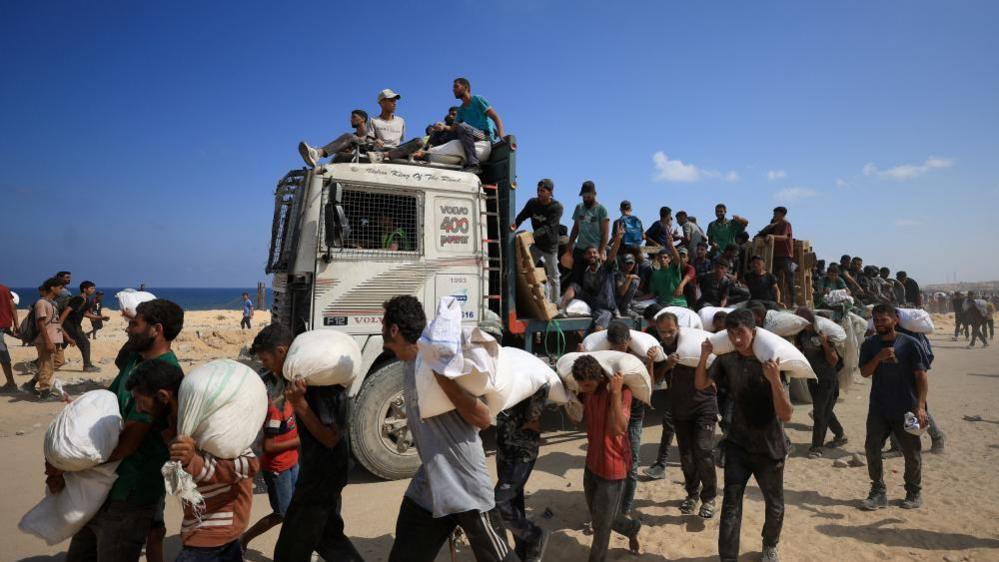Gaza death toll rises as Israeli troops fire on crowds seeking aid

An additional four people reportedly died near an aid distribution site in Khan Yunis.
Gaza’s civil defense agency reported a deadly escalation on Sunday, claiming Israeli forces opened fire on Palestinians gathered to collect humanitarian aid, leaving at least 93 dead and dozens more injured across the besieged territory.
According to the agency’s spokesperson, Mahmud Basal, 80 people were killed in the north as aid trucks arrived, while nine others were gunned down near Rafah in the south a day after another deadly incident at an aid point in the same area.
An additional four people reportedly died near an aid distribution site in Khan Yunis.
A humanitarian convoy of 25 trucks, coordinated by Theaid, came under gunfire shortly after crossing into Gaza near Gaza City. The organization said the convoy was overwhelmed by desperate civilians before being caught in the shooting.
The Israeli military, however, challenged the reported death toll, stating its forces had only fired warning shots to deter what it called an immediate threat posed by the large crowd.
As hunger deepens in Gaza, fatal incidents at aid sites have become disturbingly frequent. Authorities in the territory blame Israeli gunfire for the deaths of civilians scrambling for scarce food and essentials. According to the UN, nearly 800 aid-seekers have been killed since late May, many during chaotic distributions or along convoy routes.
Survivors painted a grim picture of the chaos. Qasem Abu Khater, 36, who had rushed to get flour in Gaza City, described seeing people crushed in panic and shot at randomly. “Tanks were firing shells without direction, and snipers were targeting us like we were animals in the wild,” he told AFP, recounting scenes of horror as bodies lay around him.
The World Food Programme denounced the violence against civilians seeking aid as “absolutely unacceptable.”
Due to strict media controls and restricted access across the Strip, independent verification of casualty figures remains difficult.
The Israeli military says it has taken steps to minimize civilian harm, including issuing new operational guidelines to soldiers following a series of similar tragedies.
In a separate move on Sunday, Israel revoked the residency permit of Jonathan Whittall, head of the UN’s humanitarian coordination office (OCHA) in Israel.
Foreign Minister Gideon Saar accused him of spreading misinformation about the conflict. Whittall has been an outspoken critic of the humanitarian crisis unfolding in Gaza.
The war, now in its tenth month, was triggered by a Hamas-led incursion into Israel on October 7, 2023, which left 1,219 people dead—mostly civilians according to an AFP tally based on official figures.
Israel's response has since claimed the lives of 58,895 Palestinians, the majority of them civilians, according to Gaza’s health ministry under Hamas authority.
Meanwhile, Israeli Prime Minister Benjamin Netanyahu issued an apology to Pope Leo XIV after an Israeli munition struck the Holy Family Church in Gaza City, killing three people. The Vatican condemned the strike, with the pope decrying the ongoing violence as “barbaric” during his Sunday Angelus message.
Latin Patriarch of Jerusalem Pierbattista Pizzaballa led a rare mass at the Gaza church on Sunday, days after visiting the war-ravaged territory.
With more than two million people affected by repeated displacement, Israel’s military on Sunday ordered those sheltering in the Deir el-Balah area to evacuate south ahead of new operations. Families were seen fleeing with whatever belongings they could carry, many using donkey carts for transport.
“They dropped leaflets warning us to leave, but we have no idea where to go. We’re without shelter, food or water,” one man told AFP.
The UN's humanitarian agency OCHA said the latest evacuation order further weakens the already crumbling support systems in Gaza.
It estimates that over 87 percent of the territory is now under evacuation orders or declared military zones, leaving 2.1 million people squeezed into a patchwork of overcrowded safe zones where essential services no longer function.
Amid the intensified military campaign, families of hostages taken during the October 7 attack have raised concerns about their safety. Negotiations between Israel and Hamas are ongoing, focused on a proposed 60-day ceasefire and the release of 10 surviving captives.
Out of the 251 hostages originally seized, 49 remain in Gaza. Israeli authorities believe 27 of them are no longer alive.
